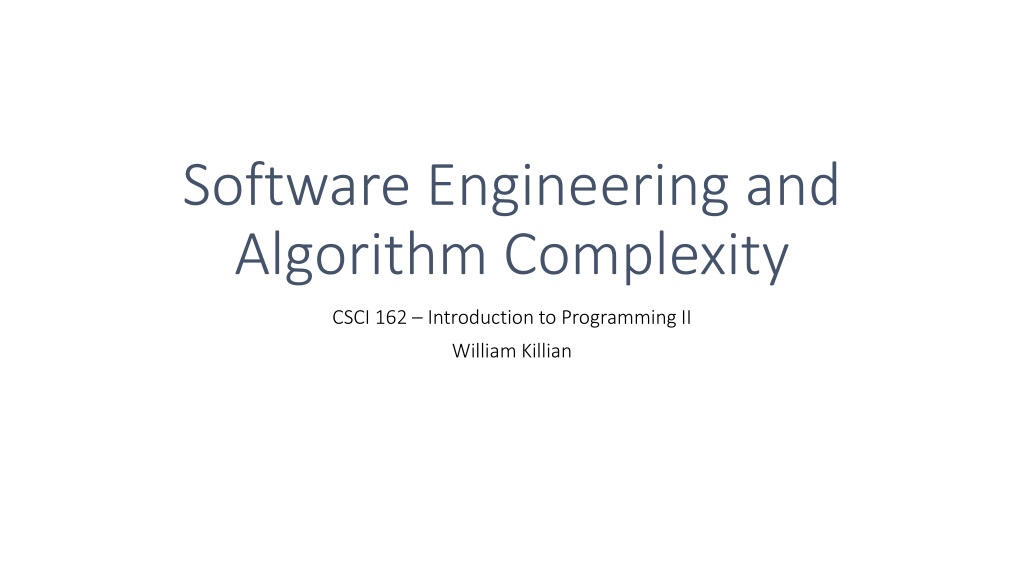
Introduction to Software Development and Algorithm Complexity
Explore the world of software engineering, data structures, algorithms, and software development processes. Learn about efficient data manipulation, object-oriented programming, specifications, design, and testing in software engineering.
Download Presentation

Please find below an Image/Link to download the presentation.
The content on the website is provided AS IS for your information and personal use only. It may not be sold, licensed, or shared on other websites without obtaining consent from the author. Download presentation by click this link. If you encounter any issues during the download, it is possible that the publisher has removed the file from their server.
E N D
Presentation Transcript
Software Engineering and Algorithm Complexity CSCI 162 Introduction to Programming II William Killian
Data Structures/Algorithms Programs = Data Structures + Algorithms Data Structures o(Efficient) storage and manipulation of (large) data sets oArrays, linked lists, trees oUsed to implement abstract data types (ADTs) like set, list Algorithms oOperations on data oFind, insert, erase, sort, reverse Object-oriented programming (OOP) oA method of programming that emphasizes information hiding and component reuse
Software Development Software Engineering oStudy of and an application of engineering to the design, development, and maintenance of software oFocus: controlling the development process to achieve consistently good results We want to osatisfy the client the person or organization who sponsors the development omeet the needs of the user the people using the software for its intended purpose 3
Software Development (Contd) [ISO/IEC 12207] Specification Maintenance, Evolution Design Testing, Debugging, Analysis Implementation 5
Specifications and Design Requirements define needed info, functionality, behavior, and performance of the system Resources specifies people, equipment, software, time, and money available Specifications describe precisely what the software should do Design describes how the software meets the specifications Implementation: translating the design into a specified programming language(s) oFollow style guidelines oDon t change the design without going to a previous phase 6
Testing and Analysis Find bugs before user does Alpha versus beta testing Regression testing Integration testing Top-down versus bottom-up Must consider oBoundary/edge cases (e.g., for sqrt function?) oExceptional cases oExpected error cases Analysis (or validation): How well does the implementation meet the specifications? 8
Lubarskys Law of Cybernetic Entomology There s always one more bug!
Brooks Law Adding more programmers to a late software project makes it later.
Deadline-Dans Demon Every task takes twice as long as you think it will. If you double the time you think it will take, it will take 4 times as long.
Gilbs 2nd Law of Unreliability Any system that depends on human reliability is inherently unreliable.
Murphys Law Just Kidding Anything that can go wrong will.
Preconditions and Postconditions Use preconditions and postconditions ospecifies what a method does onot how it does it Precondition owhat must be true before method is called Postcondition owhat will be true when method finishes 14
Example // Precondition: x >= 0. // Postcondition: The square root of x has // been written to the standard output. public void public void writeSqrt (double ... } double x) { 15
Example Which calls are problematic? writeSqrt (-10); writeSqrt (0); writeSqrt (5.6); If precondition is met, the postcondition MUST be true when the method terminates 16
Example // Precondition: letter is an uppercase or // lowercase letter (in the range 'A'...'Z' // or 'a'...'z'). // Postcondition: The value returned by the // method is true if letter is a vowel; // otherwise the value returned by the method is // false. public public boolean boolean isVowel (char ... } char letter) { 17
Example What does each call return? isVowel ( A ); isVowel ( Z ); isVowel ( ? ); Violating a precondition results in undefined behavior 18
Contracts Programmer who calls a method omust ensure the precondition is met Programmer who writes a method omay assume the precondition is true omust ensure that the postcondition becomes true when the method ends 19
Responsibilities If you call my writeSqrt method with a negative value, my method is free to reformat your hard drive! However 20
Responsibilities Make every effort to detect when a precondition has been violated Emit an error message and/or halt the program if violation detected 21
Example // Precondition: x >= 0. // Postcondition: The square root of x has // been written to the standard output. public void writeSqrt (double x) { if (x < 0) throw new IllegalArgumentException ( negative x ); ... } 22
Advantages of Preconditions and Postconditions Succinctly describes the behavior of a method Doesn t clutter thoughts with details of how the method works Allows for later re-implementing the method in a new way Doesn t break callers if they only depend on the preconditions/postconditions
Summary Precondition The programmer who calls a method ensures that the precondition is valid. The programmer who writes a method can bank on the precondition being true when the method begins execution. Postcondition The programmer who writes a method ensures that the postcondition is true when the method finishes executing.
Complexity Two types Speed Relate operations to input size Space Relate # bytes to input size Big-O notation Machine-independent means for specifying efficiency (complexity) Concerned with asymptotic behavior Generally count most significant factor and relate to input size (N) oExample: if T(N) = 9N2 + 43N + 7 then the algorithm is O(N2)
Complexity Can analyze oBest case oAverage oWorst (default) maximum # of ops. Example: linear search time complexity int[] A = { }; for (int i = 0; i < N; ++i) if (A[i] == searchValue) break; oWhat s the best case? Worst case? Average case? oFor worst case, T(N) = ? = O(?)
Complexity for for (i = N - 1; i > 0; --i) for for (j = 0; j < i; ++j) if if (A[j] > A[j + 1]) swap (A[j], A[j + 1]); What type of algorithm is this? What operation should we count? What s the worst case? oFor worst case, T(N) = ? = O(?)
